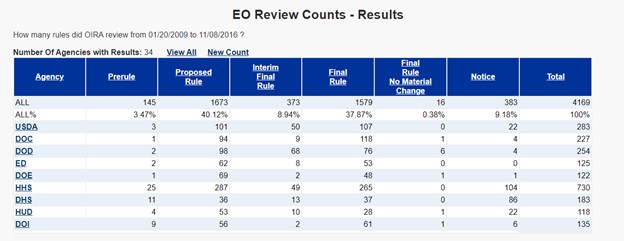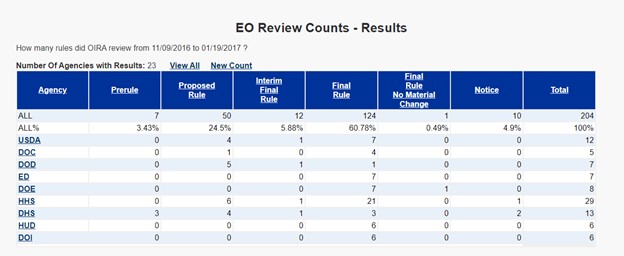Insight
November 19, 2020
Midnight Rulemaking: The Once and Future Phenomenon
EXECUTIVE SUMMARY
- As the Trump Administration enters its final days, concerns have arisen surrounding how aggressive it will be in promulgating “midnight regulations” – the designation given to rules finalized between Election Day and the inauguration of a new president.
- An examination of relevant data, however, shows that the “midnight” period under President Obama saw a nearly three-fold increase in regulatory activity over its pre-election rate.
- The data further establish that, across the past three administrations at least, the phenomenon of “midnight rulemaking” is far from some novel or unprecedented practice.
INTRODUCTION
With the 2020 election having passed, and thus the presidential transition beginning, much of Washington, DC, is looking toward what will be different come Inauguration Day 2021. There remains, however, this curious period until then in which the Trump Administration can continue to push its agenda administratively via so-called “midnight regulations.” In light of this period, the chairs of the House Committees on the Judiciary and on Oversight and Government Reform recently sent a letter to the Office of Management and Budget (OMB) urging it to restrain such rulemaking activity, citing a variety of concerns.
One key aspect of the letter is its appeal to the current leadership at OMB to replicate the supposed behavior of the preceding administration in limiting midnight rulemakings. As the letter contends:
At the end of the Obama Administration, [Office of Regulatory and Information Affairs] OIRA Administrator Howard Shelanski sent a memo to executive branch agencies that cautioned the agencies “to avoid an end-of-year scramble that has the potential to lower the quality of regulations” and “to tax the resources available for interagency review.”
A brief examination of the available data, however, demonstrates that, despite perhaps the stated intention of Administrator Shelanski, the trend of midnight rulemaking continued during the waning months of the Obama Administration. Further, the Obama Administration was in line with previous administrations’ activity, as well. Thus, the Trump Administration would hardly be outside historical norms in continuing to press forward on its regulatory priorities until Inauguration Day.
EXAMINING RECENT MIDNIGHT RULEMAKING RATES
Available data allow an examination of how many significant rulemakings an administration’s OIRA reviews over particular periods of time. This is a particularly useful data set since OIRA – and thus the administration in question – generally holds broad discretion (barring explicit legal deadlines) over how quickly it lets rules flow through the pipeline. The data for the pre- and post-election day periods of the Obama Administration are as follows.
All Pre-Election Rulemakings

Post-Election Rulemakings

For the purposes of this analysis, the only relevant data points are the final rules (the middle three columns), since all other actions would be at the mercy of the incoming administration. For the Obama Administration, there were 137 final rules reviewed during the midnight period versus 1,968 rules beforehand. There were 72 calendar days in Obama’s “midnight” period. That equals an average rate of 1.9 rules per day. That rate represents a roughly 276 percent increase over the “pre-midnight” rate of 0.7 rules per day (1,968 rules over 2,850 calendar days). While, of course, some of these days were not work days (weekends and holidays), the overall averages are meant to illustrate the relative amount of activity over a given timeframe.
Looking back to the two administrations prior to Obama’s reveals a similar historical trend:
| Administration | Midnight Days | Midnight Rules Reviewed | Midnight Rate (Rules/Day) | Pre-Midnight Rules | Pre-Midnight Days | Pre-Midnight Rate (Rules/Day) |
| Clinton | 73 | 139 | 1.9 | 4429 | 2849 | 1.6 |
| Bush | 76 | 119 | 1.6 | 2532 | 2846 | 0.9 |
| Obama | 72 | 137 | 1.9 | 1968 | 2850 | 0.7 |
Each administration saw a relative spike in activity during its “midnight” period. President Clinton’s was far less pronounced, but that is likely due to some combination of A) changes in the rulemaking review process beginning in the fall of 1993 and B) a less definitive “midnight” period given the famous uncertainty surrounding the result of the 2000 election.
CONCLUSION
The clock is ticking on the Trump Administration’s ability to push forward its policy preferences on the regulatory front. There may be prudential concerns regarding either its actions in particular or the practice of “midnight rulemaking” writ large. Those concerns, however, are for either the incoming administration, future Congresses, or the courts to address. One can expect the Trump Administration to continue apace on implementing its regulatory agenda until January 20, 2021, and it would be well within the bounds of recent precedent to do so.










